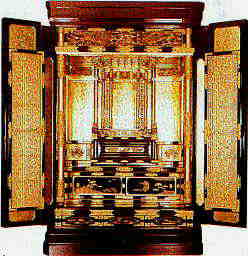| ===== INTRODUCING ===== | |
|---|---|
 | |
KYOTO | |
|
HOUSEHOLD BUDDHIST ALTARS (Butsudan) | |
& | |
| BUDDHIST OBJECTS (Butsugu) | |
Kyoto, the center of Imperial Court culture, is also the center of Buddhist culture. Temples, large and small, of many Buddhist denominations are located throughout the city. It was while meeting the demand from these numerous temples and also from households that Kyoto's Butsudan (called Kyo-Butsudan) and Butsugu (Kyo-Butsugu) developed.
The history of Butsugu goes back to the time when Shomyo, a king of Paekche (ancient Korean kingdom) presented Buddhist images and scriptures to Emperor Kinmei of Japan (who acceded to the throne in 539 A.D.). After that, as Buddhism spread, divergent forms of Butsugu developed according to the needs of different Buddhist denominations. Eventually miniatures of a temple were made for household use. These were the forerunners of the Butsudan that various families have become to possess.
Following the establishment of a new religious system in the early part of the Edo era (1603-1868), many families started to have Butudan that was evolved from the Zushi (miniature shrine) in their house. The production of Butsugu in Kyoto may be traced as far back as the eighth cenrury. But its real history can be said to have begun in the early eleventh century, when Jocho the sculptor of images of Budda gathered craftsmen and opened a workshop at Shichijo. Because many head temples of various denominations are located in Kyoto, the demand for Butsudan and Butsugu is
correspondingly great. Moreover, the market has always called for the best
quality. This is why Kyoto became the production center of Butsudan and
Butsugu from early on.
The production of Butsugu in Kyoto may be traced as far back as the eighth cenrury. But its real history can be said to have begun in the early eleventh century, when Jocho the sculptor of images of Budda gathered craftsmen and opened a workshop at Shichijo. Because many head temples of various denominations are located in Kyoto, the demand for Butsudan and Butsugu is
correspondingly great. Moreover, the market has always called for the best
quality. This is why Kyoto became the production center of Butsudan and
Butsugu from early on.